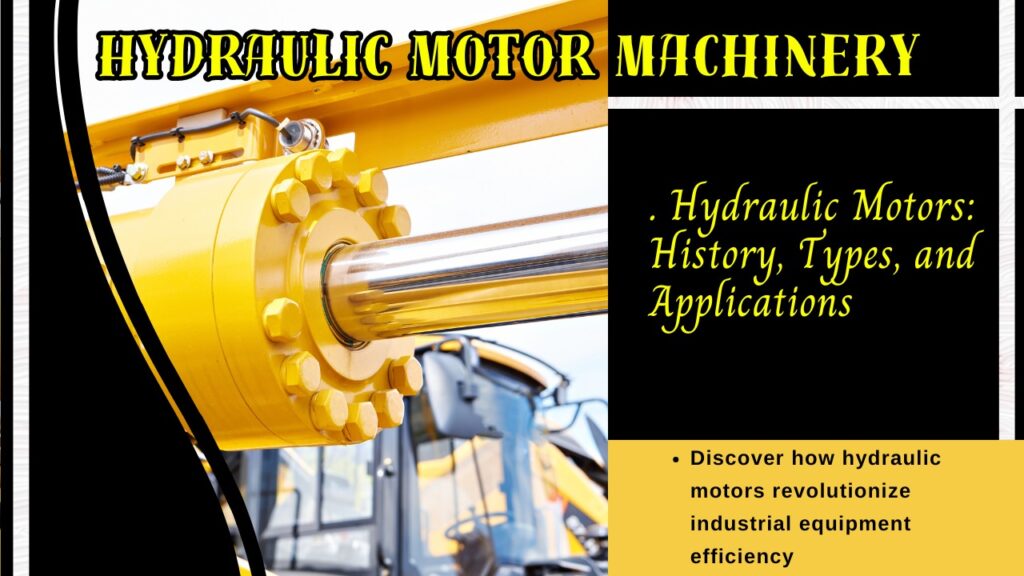A hydraulic motor is a mechanical actuator that converts hydraulic energy into mechanical energy. It utilizes pressurized hydraulic fluid to generate rotational motion and torque. Hydraulic motors are essential in various industrial, mobile, and construction applications, where they provide the power needed for tasks such as lifting, driving, and moving machinery.
Introduction
A hydraulic motor is a critical mechanical actuator that transforms hydraulic energy into mechanical energy, operating through the use of pressurized hydraulic fluid to produce rotational motion and torque. This essential component finds widespread application in industrial, mobile, and construction sectors, thanks to its ability to deliver substantial power output within a compact framework. The working principle involves the hydraulic fluid entering the motor through an inlet port, exerting force on internal components such as gears, vanes, or pistons. This force induces movement in these components, translating the hydraulic energy into rotational motion and subsequently generating torque, which is the rotational force. The fluid then exits through an outlet port at a lower pressure. There are primarily three types of hydraulic motors: gear motors, vane motors, and piston motors. Gear motors, the simplest form, utilize meshing gears and are reliable and cost-effective, though less efficient and powerful than other types. Vane motors, equipped with vanes on a rotor inside a cam ring, offer smooth operation and efficiency at lower speeds but are prone to wear. Piston motors, divided into axial and radial types, boast high efficiency and torque, making them ideal for high-pressure applications despite their complexity and cost. Hydraulic motors power diverse machinery such as industrial presses, conveyors, injection molding machines, construction equipment like excavators and cranes, agricultural machinery like tractors and harvesters, marine systems including winches and steering mechanisms, and automotive applications such as power steering systems. They are also crucial in aerospace for actuating systems in aircraft. The advantages of hydraulic motors include high power density, variable speed and direction control, robust construction, and versatility across different applications. However, they come with challenges like complexity, potential for fluid contamination, and sensitivity to temperature changes. Despite these challenges, the ability of hydraulic motors to efficiently convert hydraulic energy to mechanical motion makes them indispensable, ensuring their vital role in the evolution of various mechanical systems and their ongoing relevance in modern technology.
History Of Hydraulic Motor
The history of hydraulic motors dates back to ancient times when the principles of hydraulics were first understood and applied. Early civilizations, such as the Egyptians and Greeks, utilized basic hydraulic systems for irrigation and water management. The concept of using fluid power for mechanical work evolved over centuries.
In the 19th century, saw significant advancements in hydraulic technology, particularly during the Industrial Revolution. The development of hydraulic presses and cranes revolutionized manufacturing and construction industries. In 1882, Swedish engineer Gustaf de Laval invented the first practical hydraulic turbine, which harnessed water In the 20th century, brought further innovation with the advent of high-pressure hydraulic systems and components. The introduction of hydraulic motors in the mid-20th century enabled the efficient conversion of hydraulic energy into mechanical motion, leading to their widespread use in various applications such as construction, agriculture, and industrial machinery.
Today, hydraulic motors are an integral part of modern engineering, continuously evolving with advancements in materials, design, and technology to meet the increasing demands of various industries.
Types Of Hydraulic Motor
- Gear motors
A gear motor is a hydraulic motor that converts hydraulic energy into mechanical power through meshing gears. It comes in two types: external gear motors, with two external meshing gears, and internal gear motors, featuring an internal and an external gear. When pressurized fluid enters, it causes the gears to rotate, generating mechanical motion. Gear motors are valued for their simple, robust structure, reliability, and cost-effectiveness, making them easy to maintain and ideal for low-power applications. However, they generally offer lower efficiency and torque compared to more complex hydraulic motors like vane or piston motors.
- Piston motors
A piston motor works by converting hydraulic energy into mechanical power using a series of pistons arranged either axially or radially. In an axial piston motor, pistons are aligned parallel to the rotation axis within a cylinder block. Pressurized
hydraulic fluid enters the motor, pushing the pistons within their cylinders, which forces the cylinder block to rotate and generate mechanical motion.
- Vane motors
A vane motor operates by converting hydraulic energy into mechanical motion When pressurized hydraulic fluid enters the motor, it pushes the vanes outward against the cam ring. This movement causes the rotor to rotate, generating mechanical power. Vane motors are characterized by their simple structure and smooth operation, making them suitable for applications requiring low to moderate speeds. They offer good efficiency at lower speeds but can be susceptible to wear due to the constant contact between the vanes and the cam ring.
Hydraulic Motors Uses
Industrial Machinery: Powering hydraulic presses, conveyors, and injection molding machines.
Construction Equipment: Operating heavy machinery such as excavators, loaders, cranes, and bulldozers.
Agricultural Machinery: Driving tractors, harvesters, and irrigation systems for planting, harvesting, and field operations.
Automotive Industry: Powering hydraulic systems in vehicles, such as power steering, brake systems, and suspension components.
Aerospace: Used in aircraft for actuating flight control surfaces, landing gears, and other critical systems.
Mining: Operating equipment for excavation, hauling, and processing minerals.
Oil and Gas: Powering drilling rigs, pumps, and other equipment used in exploration and extraction processes.
Forestry: Driving forestry machinery for logging, processing, and transporting timber.
